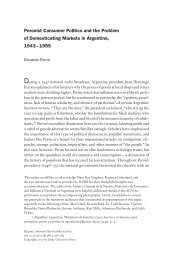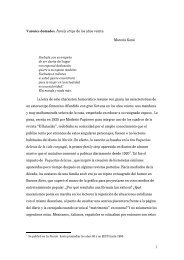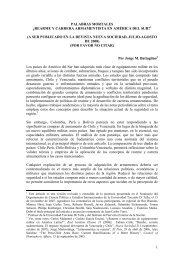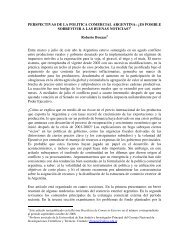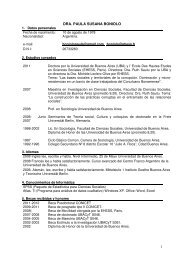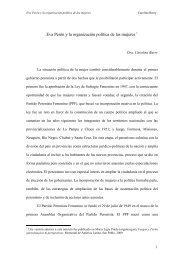Restricted mobility and fixed-mobile convergence in Brazil
Restricted mobility and fixed-mobile convergence in Brazil
Restricted mobility and fixed-mobile convergence in Brazil
You also want an ePaper? Increase the reach of your titles
YUMPU automatically turns print PDFs into web optimized ePapers that Google loves.
Vésper Portátil<br />
The first commercial use of FWA/WLL <strong>in</strong> <strong>Brazil</strong> dates back to 1999, when local carrier<br />
Telemar provided STFC with FWA/WLL <strong>in</strong> the city of Parati <strong>in</strong> the state of Rio de Janeiro.<br />
Shortly after, Bell Canada, Velocom <strong>and</strong> Qualcomm created Vésper, a jo<strong>in</strong>t venture aimed at<br />
provid<strong>in</strong>g STFC service us<strong>in</strong>g wireless technologies <strong>and</strong> compet<strong>in</strong>g with <strong>fixed</strong> <strong>in</strong>cumbents<br />
Telefônica <strong>and</strong> Telemar <strong>in</strong> the key markets of Sao Paulo, Rio de Janeiro, M<strong>in</strong>as Gerais <strong>and</strong> 14<br />
others. The arrival of Vésper was highly significant for a variety of reasons. On the one h<strong>and</strong>,<br />
it was the first attempt by a new entrant to compete with local <strong>in</strong>cumbents <strong>in</strong> mature markets<br />
us<strong>in</strong>g FWA/WLL for last-mile access. This also represented a test for the newly established<br />
legal framework that attempted to promote competition through local-loop unbundl<strong>in</strong>g <strong>and</strong><br />
asymmetric regulation between <strong>in</strong>cumbents <strong>and</strong> new entrants. Lastly, as the regulatory<br />
battle moved to the courts, the judicial outcome was perceived as a key signal about the role<br />
that the judiciary would play <strong>in</strong> the new <strong>Brazil</strong>ian telecom regulatory environment.<br />
Bell Canada, Velocom <strong>and</strong> Qualcomm <strong>in</strong>stituted Vésper to provide STFC <strong>in</strong> the state of Sao<br />
Paulo <strong>and</strong> other 16 states <strong>in</strong> <strong>Brazil</strong>, <strong>in</strong>itially compet<strong>in</strong>g with two local carriers for <strong>fixed</strong> phone<br />
services: Telefônica, <strong>in</strong> the state of Sao Paulo, correspondent to the area with highest <strong>in</strong>come<br />
<strong>and</strong> population density <strong>in</strong> <strong>Brazil</strong>, that is Region 3 of the General Plan of Concessions (PGO);<br />
<strong>and</strong> Telemar, <strong>in</strong> the states of Rio de Janeiro, M<strong>in</strong>as Gerais, Espírito Santo, Bahia, Sergipe,<br />
Alagoas, Pernambuco, Paraíba, Rio Gr<strong>and</strong>e do Norte, Ceará, Piauí, Maranhão, Pará,<br />
Amapá, Amazonas <strong>and</strong> Roraima, correspondent to Region 1 of the PGO, which<br />
encompasses the North <strong>and</strong> East regions of the <strong>Brazil</strong>ian territory.<br />
The use of FWA/WLL by Vésper was approved by Anatel’s Resolution 271 of August 6, 2001,<br />
which authorized the use of cellular h<strong>and</strong>sets for FWA/WLL applications as a substitute for<br />
STFC customer premises equipment. Vésper decided to deploy term<strong>in</strong>als embedded with<br />
CDMA IS-95 technology that worked at 14.4 Kbps. The network admitted roam<strong>in</strong>g <strong>and</strong><br />
h<strong>and</strong>off-h<strong>and</strong>over. Vésper also offered customers the ability to orig<strong>in</strong>ate calls <strong>in</strong> a radius up<br />
to 9 km around the subscriber’s home or office, while the <strong>mobility</strong> area for a call <strong>in</strong> progress<br />
was equivalent to the city of Sao Paulo area <strong>and</strong> two nearby cities.<br />
By allow<strong>in</strong>g customers a certa<strong>in</strong> degree of <strong>mobility</strong>, Vésper was test<strong>in</strong>g the limits of the<br />
established separation between <strong>fixed</strong> <strong>and</strong> <strong>mobile</strong> services. As expected, <strong>mobile</strong> operators<br />
were the first to raise concerns about the ability of STFC licensees to compete <strong>in</strong> a market<br />
reserved for SMP licensees. In 2001, Telemar <strong>and</strong> Telemig filed adm<strong>in</strong>istrative compla<strong>in</strong>ts<br />
aga<strong>in</strong>st Vésper with Anatel, which <strong>in</strong> its first decision issued <strong>in</strong> August 2002 suspended the<br />
deployment of Vésper’s services. The suspension was revoked a month later, when the<br />
regulator established that Vésper’s services should be limited to so-called restricted <strong>mobility</strong><br />
areas. Still, Anatel prevented any new deployment before it could certify that the operator<br />
complied with the above restrictions.<br />
At the same time, <strong>mobile</strong> operators also filed suit <strong>in</strong> the state of Rio de Janeiro, argu<strong>in</strong>g that<br />
Vésper was emulat<strong>in</strong>g <strong>mobile</strong> services restricted by federal regulation to SMP licensees. The<br />
pla<strong>in</strong>tiffs’ argument was based on the fact that <strong>fixed</strong> services bounded users to a specific<br />
home or office address, <strong>and</strong> asked for a judicial annulment of Anatel’s rules allow<strong>in</strong>g STFC<br />
licensees to deploy wireless personal voice <strong>and</strong> data communications term<strong>in</strong>als. In<br />
September 2004, the Superior Court of Justice recognized state jurisdiction over the issue.<br />
In August 2007, the Rio de Janeiro Court of Appeals concluded that Vésper did not violate<br />
STFC regulations. Accord<strong>in</strong>g to the Court, <strong>mobile</strong> operators failed to prove that the mere<br />
employment of <strong>mobile</strong> devices violated federal rules that bound <strong>fixed</strong> telephony services to a<br />
specific address, especially due to the chang<strong>in</strong>g nature of customers’ real estate<br />
dimensions. On December 2008, the Superior Court of Justice denied an appeal by <strong>mobile</strong><br />
operators, confirm<strong>in</strong>g the rul<strong>in</strong>g that the mere technical possibility of h<strong>and</strong>set <strong>mobility</strong><br />
beyond the geographic area of the client’s home or office did not violate the terms of STFC<br />
licenses.<br />
The Vésper case reveals a regulatory l<strong>and</strong>scape <strong>in</strong> which the regulator struggles to draw the<br />
l<strong>in</strong>e between <strong>fixed</strong> <strong>and</strong> <strong>mobile</strong> services, which led to a protracted regulatory battle <strong>in</strong> the<br />
courts. While the judiciary process ended by <strong>and</strong> large <strong>in</strong> a victory for Vésper, the lengthy<br />
VOL. 13 NO. 1 2011 j<strong>in</strong>foj PAGE 35



